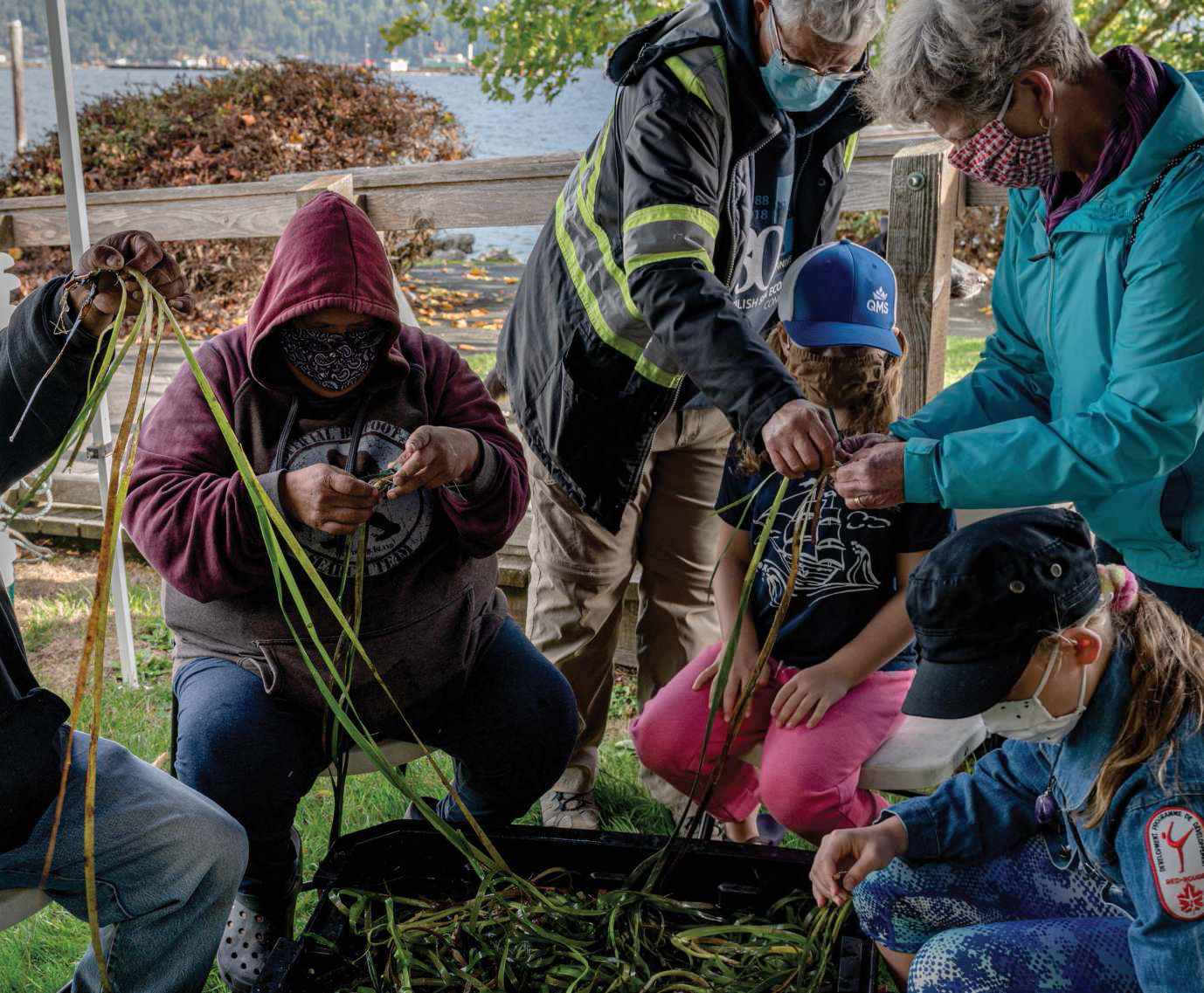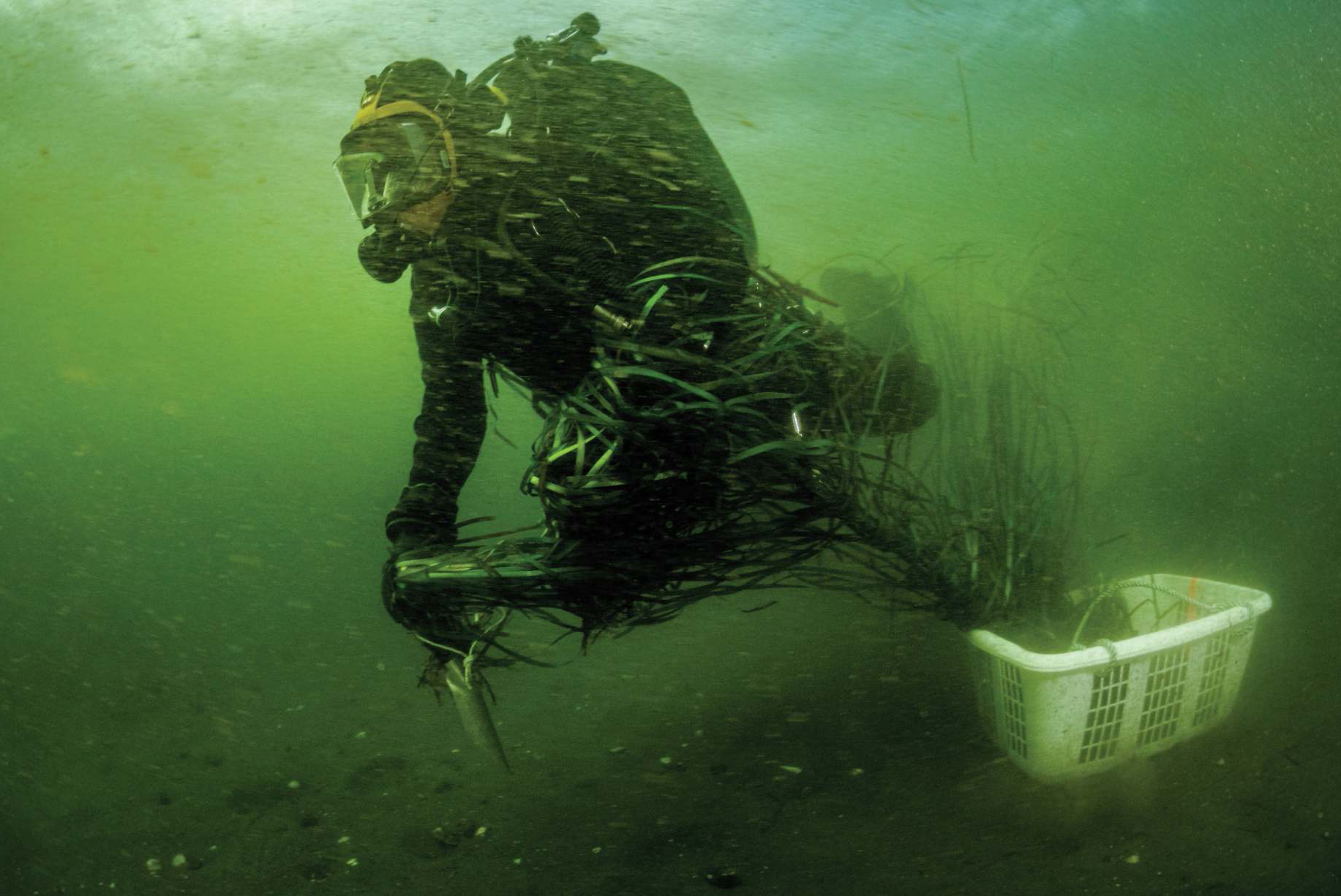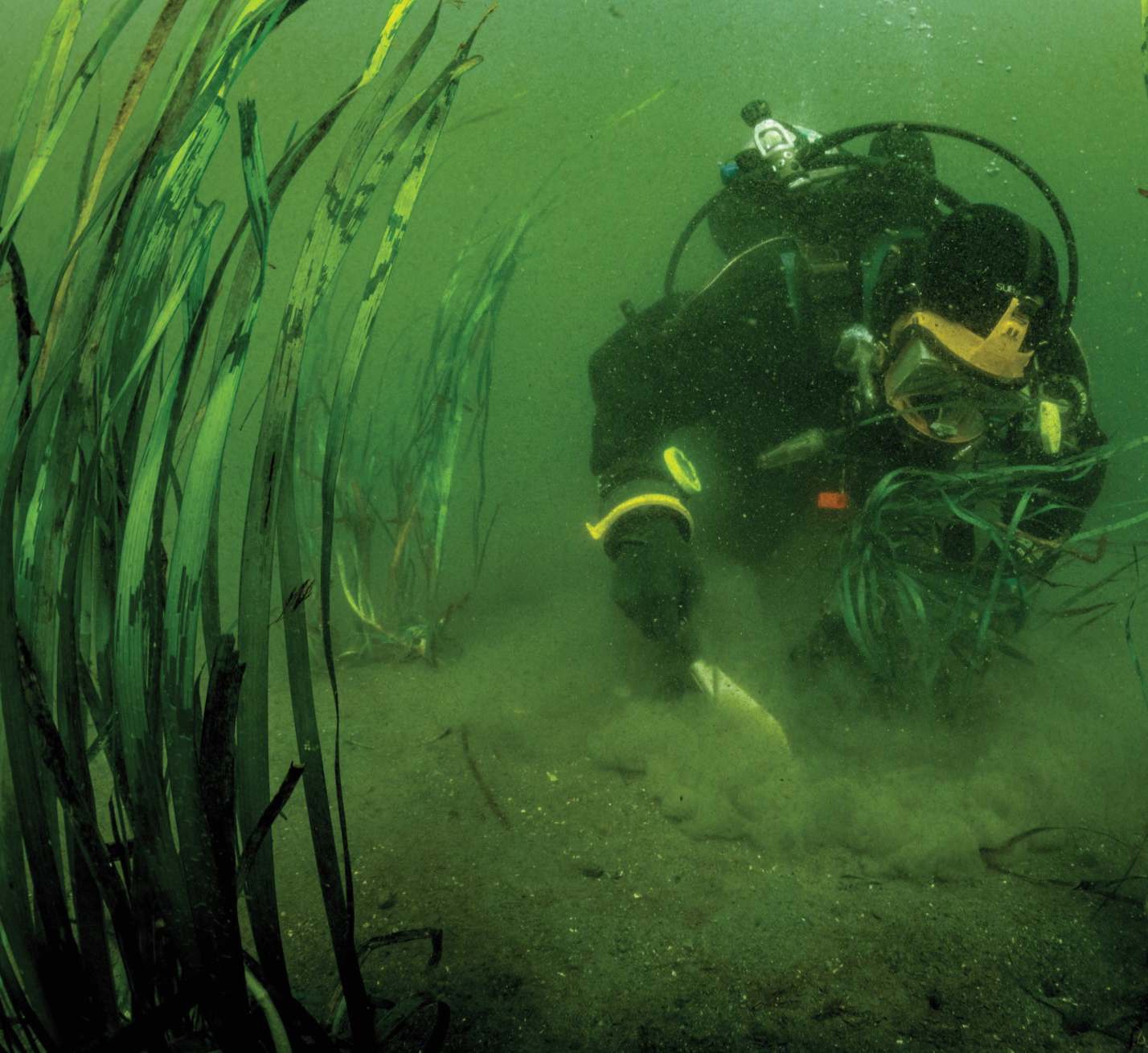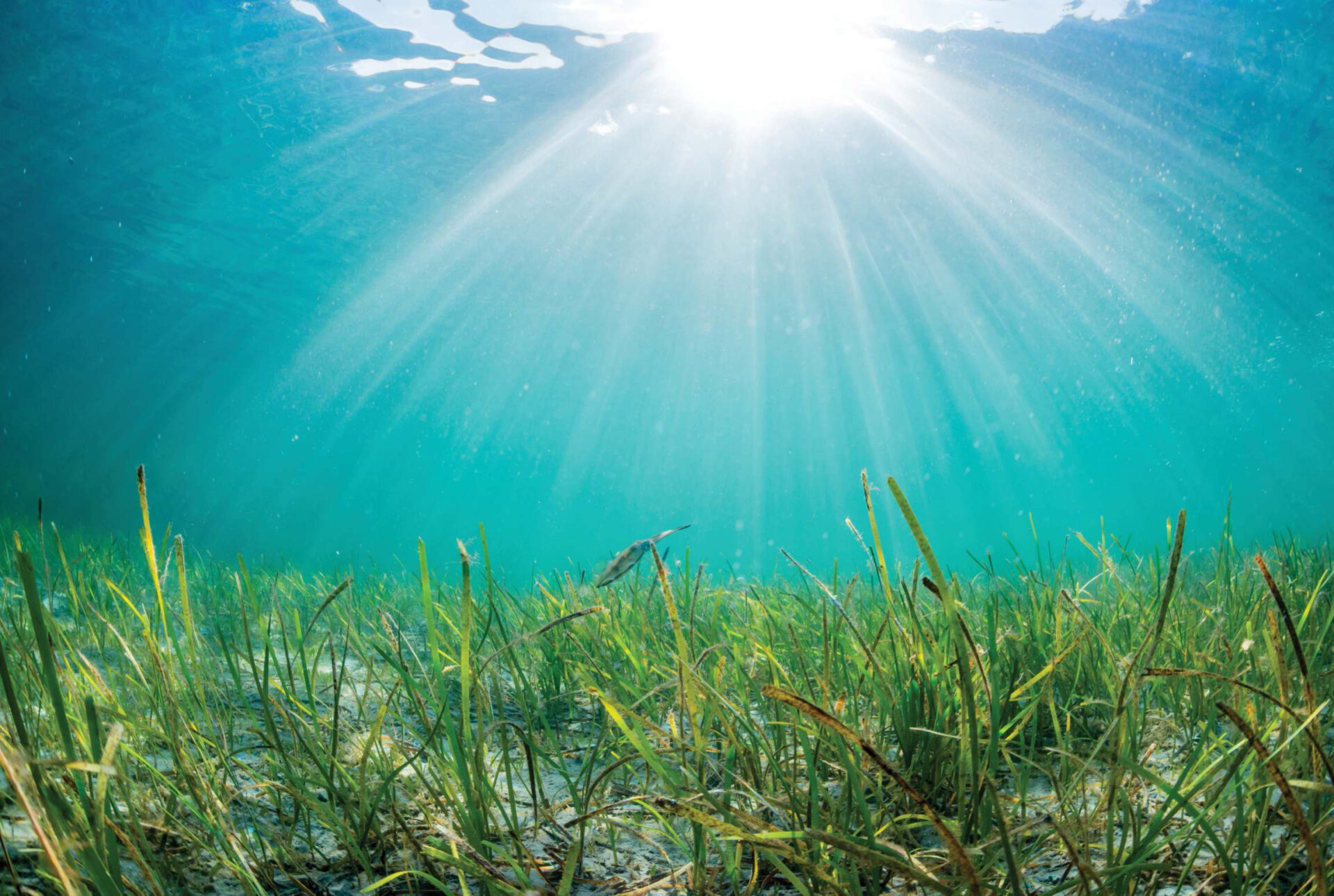The blue heron stands on a single leg in the shallows of Sidney Island near Victoria, the bird’s shadow barely registering on the water’s shimmering surface. Clusters of tall, ribbonlike, green eelgrass leaves undulate gently below the surface. With a lightning-fast movement, the heron plunges its yellow beak into the water, emerging with a small fish that had counted on the eelgrass meadow to keep it somewhat safe from predators.
Swedish taxonomist Carl Linnaeus classified the eelgrass genus as Zostera in 1753; it has at least 16 different species. Eelgrass is found on every continent except Antarctica—even in such cold places as the James Bay portion of the Hudson Bay. In British Columbia and the US Pacific coast the specific species is Zostera marina; it grows in salt and brackish waters along shallow shorelines, bays, inlets and river estuaries. It thrives in soft mud bottoms, intertidal zones and tidal pools. It doesn’t grow well on shores prone to forceful storms and prefers clear, unpolluted water to photosynthesize. Eelgrass can be found in the shallow heads of BC’s many glacier-carved fjords, but it cannot settle where the shoreline falls straight into deep water.

Eelgrass is also called “seagrass” or “seawrack,” even “an underwater lawn.” It’s sometimes misidentified as a seaweed, but eelgrass is a perennial, tidewater and underwater flowering plant, or angiosperm, not a seaweed belonging to the algae family. Its leaves are narrow, from two to 20 millimetres, and they can reach about one to 1.5 metres in length. From a drone’s eye, you can see forests of eelgrass forming green ribbons on the edges of our coastlines; this narrow region where water and land meet has been called a “bioband.”
Why is this aquatic plant important? Eelgrass plays a central role in stabilizing coastlines and fixing sediment in place through its extensive root systems. Its meadows attenuate wave and current action and prevent erosion. It provides a carbon sink and helps supply the oxygen we breathe.
Bamfield-based Louis Druehl, one of the world’s foremost kelp experts, says, “The beds take up heavy metals, like lead, mercury and cadmium, so they help reduce these toxins and clean the water. But most of all, I see its value as a carbon catcher, absorbing CO2 from the atmosphere and through photosynthesis, converting it to oxygen, which drives and feeds life around it.”
And at the Smithsonian website Pamela Reynolds writes, “Veins transport nutrients and water throughout the plant and have little air pockets called lacunae that help keep the leaves buoyant and exchange oxygen and carbon dioxide throughout the plant.”
Within eelgrass’ food web, microscopic algae grow on its leaves and provide food for snails, crab and shrimp. The plants provide a breeding ground, a nursery and habitat for young and mature salmon, perch, baby octopus, other invertebrates and shellfish. Herring lay their eggs on eelgrass. It’s estimated that up to 80 percent of fish and invertebrates use or shelter in eelgrass during part of their lifespan. Eelgrass also provides foraging grounds for resident and migrating waterbirds, especially brant geese. At low tide, wolves and river otters sometimes stalk tasty morsels in eelgrass meadows. Research has shown that when eelgrass fields decline, so do fish species and marine life diversity. According to the Smithsonian website, it’s believed that eelgrass first grew on land and then migrated to shallow coastal waters about 100 million years ago.
Many international, regional and local studies on the ecology and importance of eelgrass have been published. Such organizations as the Massachusetts-based Woods Hole Oceanographic Institution and the Marine Ecosystem Restoration in Changing European Seas headquartered in Ancona, Italy, all include eelgrass ecosystems in their research.

Eelgrass has more than one way to propagate. Its flowers are both male and female and can pollinate while submerged. The male plants’ pollen spread and fertilize the females’ flower pistils. Seeds float away on currents and are able to colonize other shorelines.
The most common way eelgrass reproduces, however, is by putting out new shoots from its stems, called rhizomes, that run underground horizontally. Most of us have experience with this form of plant reproduction in our gardens—horsetails, mint or bamboo can completely overwhelm other plantings by spreading its roots and putting out new plants. For eelgrass, it’s an efficient way of seizing new territory; while the rhizomes send out roots to find nutrients in the substrate, they also put out shoots from nodes from which new plants sprout—thus continually cloning themselves.
Indigenous people collected eelgrass rhizomes for their food value. In her UVic master’s thesis, Severn Cullis-Suzuki described the sustainable eelgrass gathering techniques of the Kwakwaka’wakw, who call the plant ts’áts’ayem. The Kwakwaka’wakw peoples are traditional inhabitants of Vancouver Island and costal mainland BC areas. She consulted with elders and stayed with various Indigenous groups. In her thesis she writes that only after eating a traditional Indigenous flour-and-sugar-free diet for a couple of weeks did she “realize how much sugar there is in the eelgrass rhizome, and that at the end of winter, after a season of eating dried foods, the green, sweet shoots of eelgrass would be extremely desirable.”
Eelgrass is under stress. It has both natural and human enemies. A microscopic slime mold called Labyrinthula zosterae can infect it with eelgrass wasting disease. The mold puts brown and black spots on the leaves, preventing photosynthesis. It’s as infectious as Omicron among humans and eventually kills the plant. A major episode took place in the 1930s and destroyed up to 90 percent of eelgrass around the world. It wasn’t only a catastrophe for the environment, but also an economic one—its leaves were collected (scythed like wheat) to make home insulation and sound proofing, packing material, stuffing for pillows, mattresses and furniture and fertilizer. On one Danish island, people thatched their roofs with eelgrass.
Today, eelgrass is no longer harvested as a commercial product, but it’s assigned a value for its contributions to the ecosystem. A Swedish study, for example, estimated that “a hectare of eelgrass, including the organic material accumulated in the sediment, produces an additional 626 kilograms [of] cod and 7,535 wrasses [a coastal fish], and sequesters 98.6 tons of carbon and 466 kilograms of nitrogen.” Emmett Duffy, director of the Marine Global Earth Observatories at the Smithsonian, puts eelgrass’ value in monetary terms: “A single hectare (about 2.5 acres) is conservatively estimated to be worth over US $19,000 a year.”
Human activity also deters the health of eelgrass fields. Development, marinas, log booms, boat anchors, buoys, and pollution all contribute to eelgrass die-off. Consequently, many research groups, all-levels of government, communities and non-profits in Canada, the US and Scandinavia have undertaken studies to survey and assess the health of eelgrass on their local coasts and estuaries.
Regionally, the Mayne Island Conservancy is but one group who has surveyed the island’s eelgrass beds and have replanted several areas. The Islands Trust, which covers all the Gulf Islands and Howe Sound, has developed baselines for existing eelgrass meadows. Several environmental groups have taken direct action: a combination of community and regional organizations and their volunteers are replanting eelgrass, one plant at the time, in the Gulf Islands, Vancouver Island, Howe Sound, Bowen Island, Sechelt and beyond.
One of the earliest transplanters I spoke with is Nikki Wright, executive director of the SeaChange Marine Conservation Society. The organization has been re-establishing eelgrass fields since 2000. “I evolved to eelgrass restoration,” she told me. “In 1998 I was harvesting sea critters to educate kids about marine life, but I soon realized I didn’t want to take from the sea, I wanted to give back to it. Eelgrass was a great place to start.”
Wright explained that the active logging on our coasts hasn’t been kind to eelgrass. Logs are tied into booms and while stored in coastal waters, prevent sunlight from reaching eelgrass and other vegetation. Even after booms leave, the bark that’s peeled off the logs overlays the seafloor bottom and creates anoxic zones—areas depleted of usable oxygen. Vegetation and marine creatures vanish.

Wright credits seagrass scientist Cynthia Durance with listening to the alarms about eelgrass falloff. She helped guide SeaChange’s first eelgrass replanting effort by establishing protocols that maximize chances for new plants to thrive. “One bit of advice,” said Wright, “is to avoid replanting in areas where multiple mooring buoys have been installed— as boats circle in wind and currents, the buoys’ lines and chain scour the bottom and kill off eelgrass colonies.”
To find out where the plants are likely to take root, SeaChange verified where eelgrass had previously prospered. One such place was Tod Inlet, which had once served as a dumping ground for Robert Butchart’s Vancouver Portland Cement Company in the early 1900s (his wife Jenny eventually built the world-famous Butchart Gardens). SeaChange located less contaminated sites and developed a system for planting eelgrass there. They’ve expanded their efforts in other locations, including Burrard Inlet, Howe Sound, Burgoyne Bay and Gabriola Island.
Since 2000, SeaChange has replanted eelgrass at 33 BC sites, following a specific recipe. “We collect healthy plants from an abundant site,” said Wright. “We store the 1,200 to 1,800 plant clusters in tubs and our volunteers separate them into individual plants, each with a piece of rhizome. They attach a non-galvanized iron washer with a twist tie near the rhizome. The washer weighs down the plant so it won’t float away in the currents. Scuba divers take laundry baskets filled with individual plants to the sea bottom and plant them in groups of 10 about a metre apart. The plants’ rhizomes then fill in new plants over time.”
Wright recalls the first time she dove down to see what had happened in Tod Inlet after eelgrass had been replanted. It had only been a day after the shoots had been introduced. She was elated to see crabs scampering among the stalks and small fishes darting around. “It was as if the eelgrass was providing housing for previously homeless creatures,” she said.
I also spoke with senior staff biologist Jennifer Sutherst of the Comox Valley Project Watershed Society, which is dedicated to improving and monitoring eelgrass, saltmarsh and kelp habitat, among other projects. The society is particularly interested in creating habitat for young salmon, which are decreasing at an alarming rate. “We launched an eelgrass pilot project in 2010,” she said. “[Scientist] Cynthia Durance trained us how to take eelgrass shoots from a healthy donor bed, along with a two- to three-inch piece of rhizome. [Like SeaChange], to ensure the plants didn’t sweep away in the current, we anchored each plant with an iron washer. We inserted a bundle of 10 plants per square metre.”
The society also made certain each transplant would be placed in an area compatible with its former location. “Shoots from the intertidal zone were planted in that same environment,” Sutherst said. “Our volunteers could plant at low tide. But for the deeper water plants, we used professional divers.”
The approach worked well and the eelgrass beds have expanded vigorously. With funding from the Oceans Protection Plan and Fisheries and Oceans Canada, the society has expanded its efforts between Oyster River to Bowser—about 120 kilometres of shoreline. “Based on our survey,” said Sutherst, “we transplanted 1,000 square metres in the Comox Estuary, Miracle Beach and near Fanny Bay.“
The challenges for eelgrass in the 21st century are huge. Besides the damage already done by human enterprises, it remains to be seen how the growing challenges from climate change will impact this important aquatic resource. Eelgrass has evolved over the past 140 million years and has been able to adapt in diverse locations and environmental conditions. But today, the world’s oceans are increasing in temperature, the waters’ pH and salinity are changing, the number of storm systems are escalating and growing more powerful and pollutants continue to enter our environment. The changes taking place aren’t the slow evolutionary paths of the past—they are rapid. Whether eelgrass, this bioband providing us with oxygen and essential services to the aquatic food web, can evolve quickly enough to survive remains the question.


